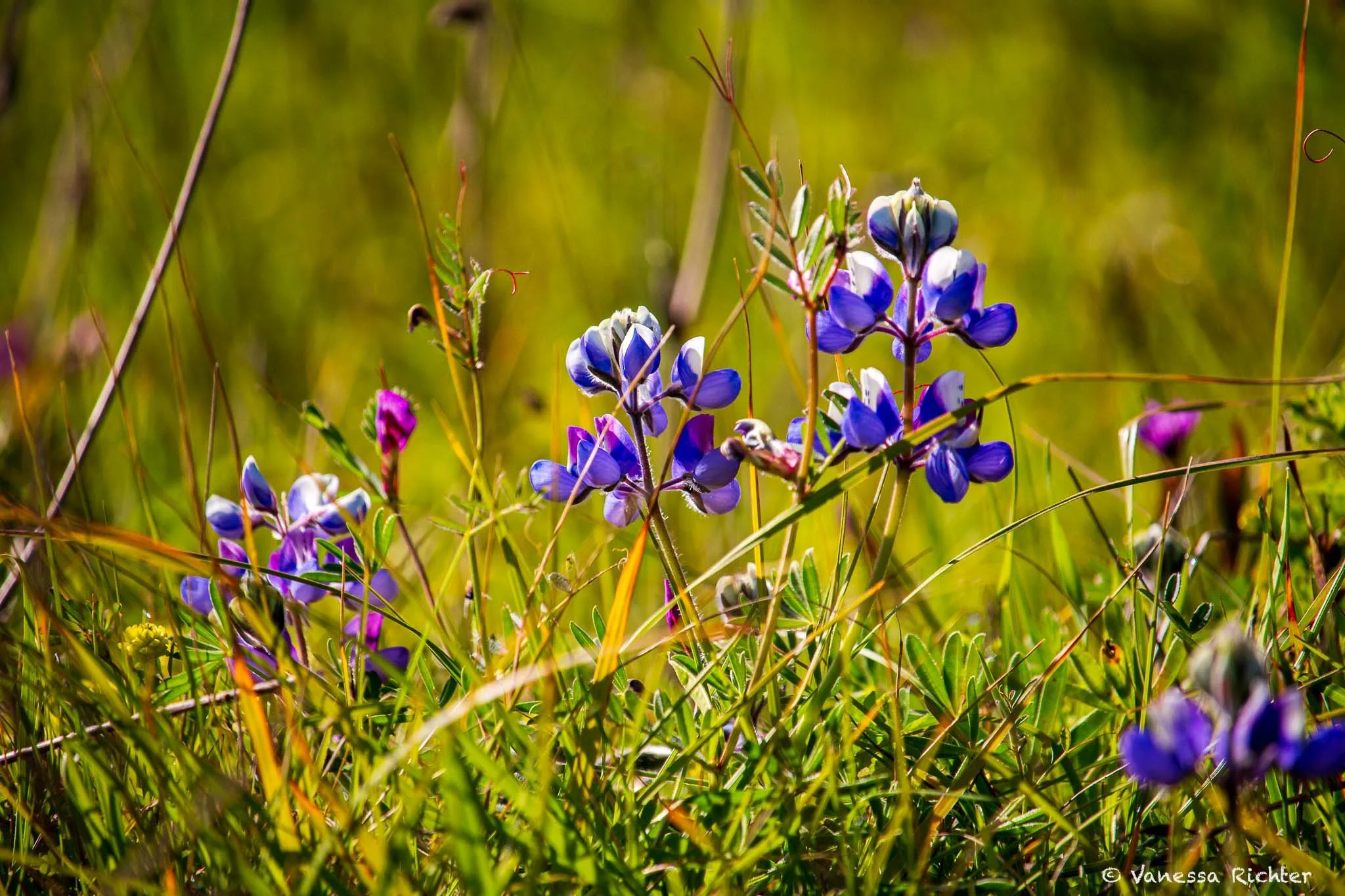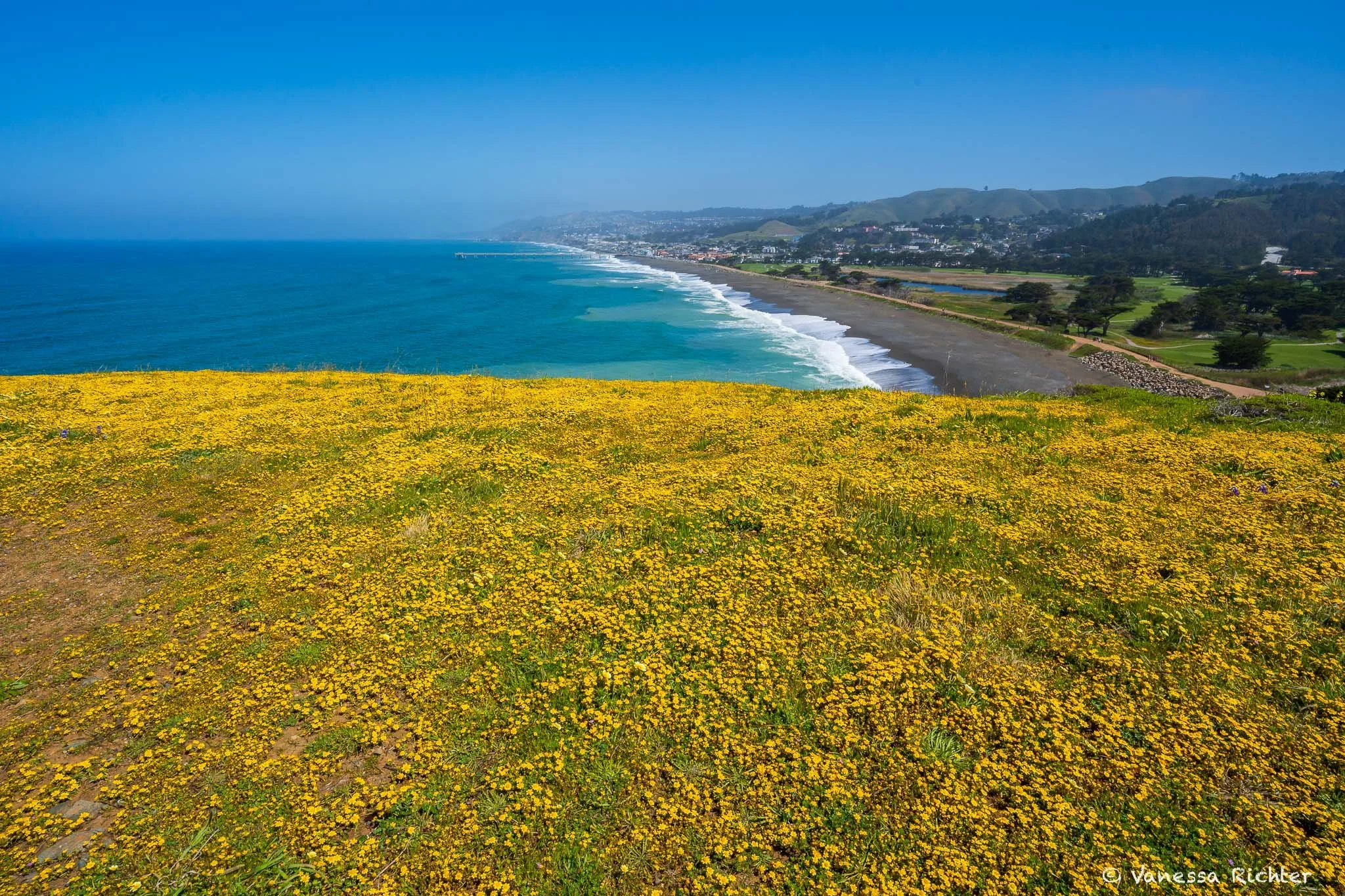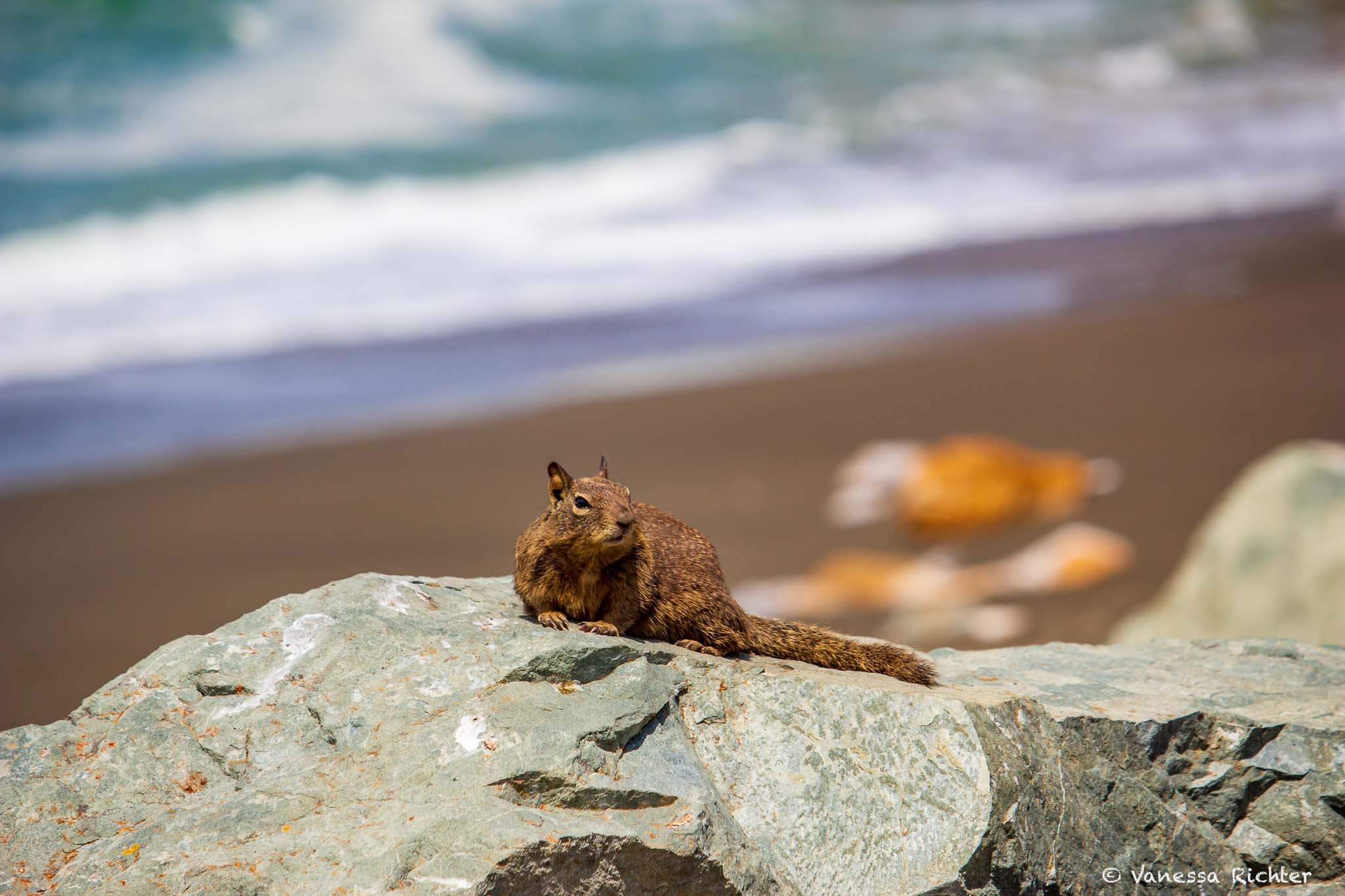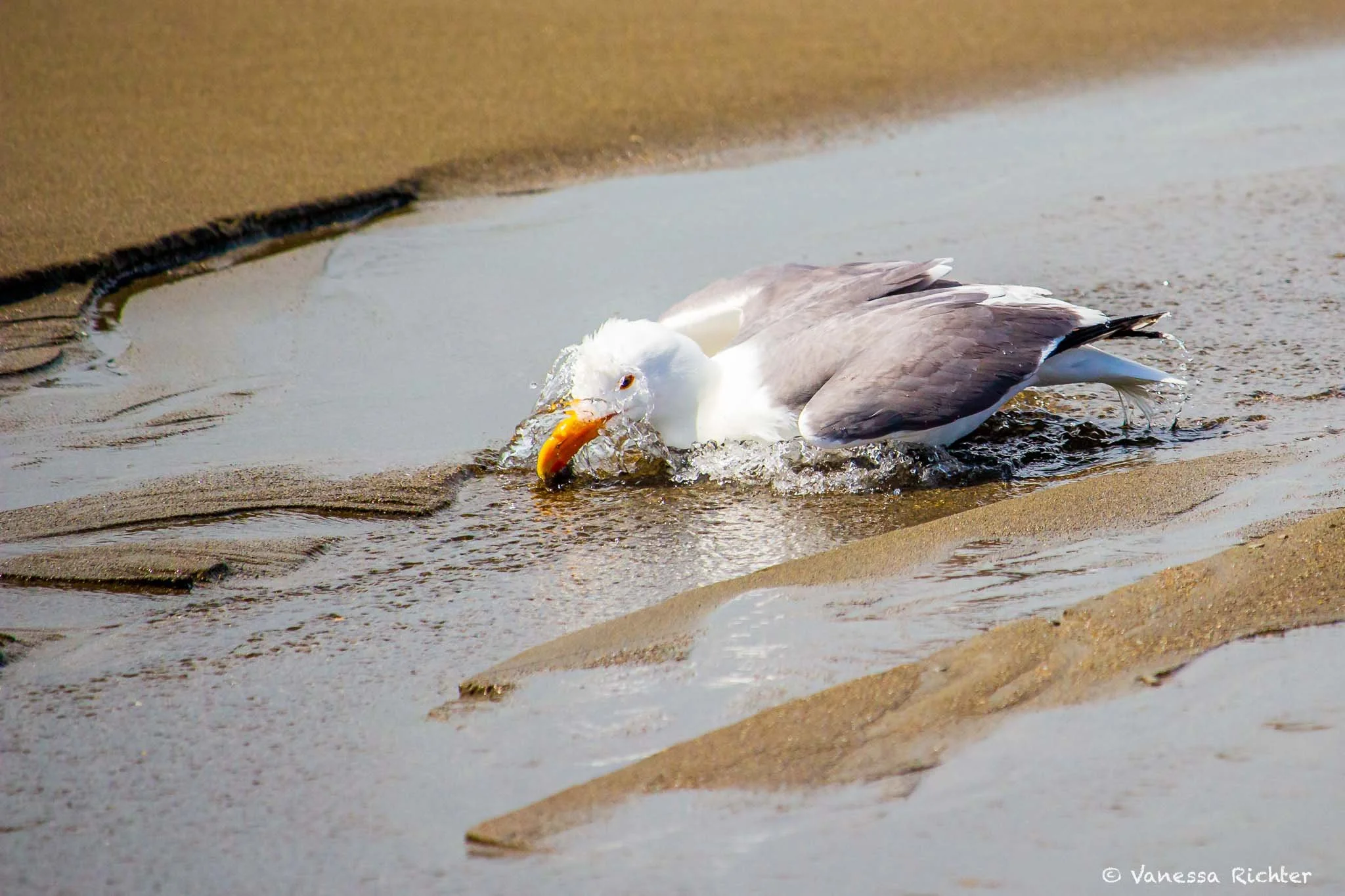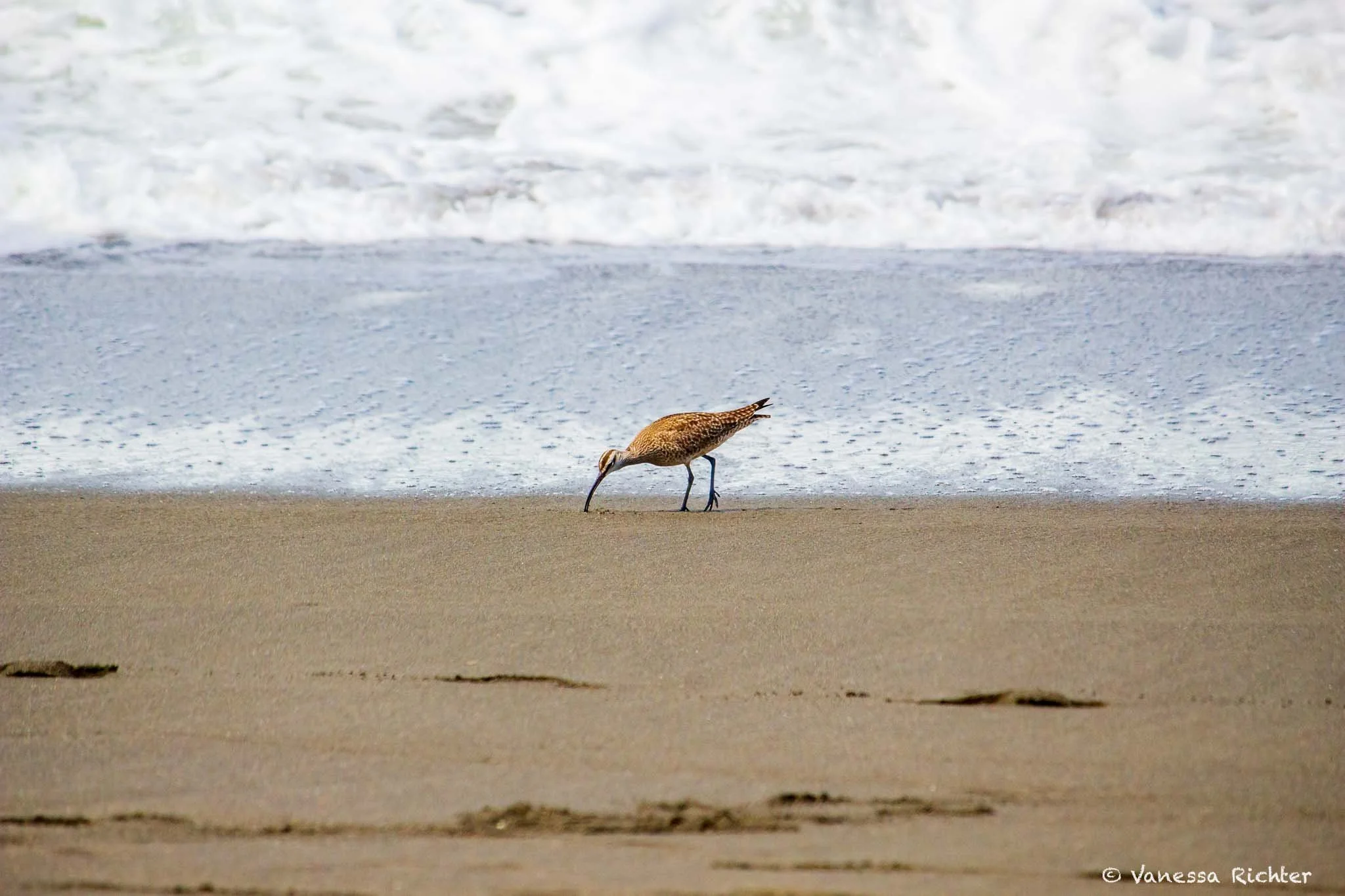Mori Point Hike: Admiring Coastal Habitat Restoration along the Pacific Coast
Mori Point, located just south of the City of Pacifica, is a beautiful place on the Californian coastline and is only a short drive from San Francisco. With its rugged bluffs, the wild ocean crashing at the shore, black beaches, carpets of wildflowers in spring, and abundant wildlife, Mori Point is an awe-inspiring example of what is possible when restoring natural landscapes after decades of exploitation.
In a Nutshell: History & Restoration
When you visit Mori Point today, you will appreciate it as a stunning and pristine natural site that offers serenity and peacefulness for those who visit.
It hasn’t always been like that. Far from it.
Historic Land (Ab)use
Mori Point has an eventful history as the former site of a limestone quarry, bootlegging, ranching, sand and gravel extraction and dirt bike racing.
Human exploitation of the land began in the 1700s. The Spanish used the land for mining (limestone quarrying), agriculture and cattle ranching. The namesake of Mori Point, Stefano Mori, bought 19 hectares of farmland here in 1888. During Prohibition, the family's main business was the infamous Mori Point Tavern. During World War II, gravel and sand were extracted at Mori Point. Later, the landscape was further devastated by the use of off-road vehicles. The introduction of non-native species and the lack of established trails led to further habitat loss and degradation.
Endangered Species
The area is home to the endangered San Francisco garter snake and the threatened California red-legged frog.
The San Francisco garter snake is a stunning sight for those lucky enough to spot one (I am not among the fortunate) with its bright orange head, dazzling black and red stripes on its back, and a turquoise belly. Once, it was common in small marshes on the San Francisco Peninsula — now, it is more often found in zoos than in the wild due to habitat loss caused by human development, pollution, and illegal collection. Please find more information on the website of the U.S. Department of Fish and Wildlife.
The California red-legged frog is the largest native frog west of the Continental Divide. It was once common in ponds and wetlands from Mendocino County to Baja California. Threatened by invasive species and habitat loss, they have today been extirpated from 70 percent of their former range. Again, please find more information on the website of the U.S. Department of Fish and Wildlife.
A Silverlining: Successfull Habitat Restoration Efforts
In 2000, with the assistance of the Pacifica Land Trust, the Coastal Conservancy, and community members, Mori Point was purchased by the Trust for Public Land.
It was transferred to the National Park Service in 2002.
In 2007, the Parks Conservancy and National Park Service launched an extensive restoration effort to restore habitat and rehabilitate trails for visitors to enjoy.
With the help of hundreds of community volunteers, 33 acres of wetland, grassland, and coastal scrub habitat were restored, including habitat for the endangered San Francisco garter snake and the threatened California red-legged frog. New trails and boardwalks were established, and directional and interpretive signage to guide and inform visitors was installed.
Learn More & Get Involved
You can find more information on history and restoration efforts on the website of the national park service and parks conservancy.
If you want to volunteer and help restore natural spaces across the Golden Gate National Park Conservancy Area, you can find numerous opportunities here. I am a volunteer myself (within San Francisco, not at Mori Point yet, though), and I can say that it is an incredibly rewarding and mood-boosting activity. Plus, you’ll learn about California native (and invasive) plants, as well as other restoration and landscaping-related topics.
Hiking Mori Point
My little spring-wildflower adventure began amidst the bustle of San Francisco. The weather was beautiful that mid-April morning, and wildflowers had started to pop up everywhere, so I was eager to leave the city behind for a while. While public transportation works really well within the city (in my humble opinion), I was a bit skeptical about how well it would work for getting to the hike. Nonetheless, I decided to give it a try. After grabbing a coffee and a snack, I soon found myself sitting in a rattling BART train. They always sound like the metal walls are as thin as paper, but, well, they get the job done. The train took me to Daly City, where I hopped onto a bus to Pacifica. Although the bus had numerous potential stops along the way, it wasn't full at all, so it went past most of them and made its way swiftly to my destination. I was the only one getting off there, and as I walked through a residential area on my way to the trailhead, I couldn't help but find it eerie how quiet and peaceful it appeared on a Thursday morning when most people are at work.
*Note: There are beautiful hikes in San Francisco, too; I was just looking for something different this time! If you’re interested, check out my article about my favorite hikes in San Francisco, for example.
Let’s get started — Mori Point Trailhead
Quicker and more smoothly than expected, I arrived at the trailhead parking lot around 9:30 am. Obviously, I didn’t have to bother about parking without a car, but I appreciated the typical trailhead restroom, which did not seem to have seen many visitors this morning. After a final glimpse at the information board about the area, I started my hike on the Old Mori Road, which led me through a path with dense vegetation to the left, already featuring a couple of flowers during this time of year, and private gardens to the right. Apart from very few people walking their dogs, I did not cross paths with many people at first. I was eager to get to higher ground to get some views of the Pacific Ocean again. After a short walk, the Lishumsha trail offered a way up onto the bluffs, and I took this first chance to gain some elevation. Quickly, the Lishumsha trail merged into the coastal trail. I kept left to head straight towards the headlands. Along the way, I stopped frequently, admiring a variety of California native wildflowers along the trail.
Lupines grow amidst the grassy areas along the trail up to the bluffs at Mori Point.
Once I had reached the top, I was blown away by the carpets of flowers that lay themselves out on the hillsides. The further I walked down to the tip of the tongue, the windier it got, but I didn’t mind at all. I was just too fascinated by the color display in front of me. Thousands of goldfields were forming a mat of flowers. In between, they accepted — among others — poppies and lupines to grow within them.
Carpets of goldfields cover the hillsides of the bluff with a view of Sharp Park Beach.
Zooming into the flower fields spotlights more flowers growing amidst the goldfields: poppies and lupines are among them.
Once I reached the tip of the promontory, I sat down and began to sip on my now half-cool coffee, which I had brought along to enjoy in this beautiful setting—and I found this spot to be more than perfect. I positioned myself (with a safe distance) towards the edge of the cliff, overlooking a cove and the southwestern part of Mori Point. Numerous fellow wildflower seekers, hikers, locals walking their dogs, and bikers traversed the headlands, while I lingered for a moment longer, absorbing the sound of seagulls above me and the waves crashing below, echoing against the steep cliffs.
I admired the black sands of the beach, which seemed so serene (as I always feel when there are no footprints in the sand), with the water rhythmically surging toward the cove and then receding like clockwork. In the restless ocean, I suddenly noticed movement. I reached for my binoculars in my bag to get a closer look and spotted a seal swimming near the shore, periodically emerging above the water's surface.
Stunning view of a small cove on the promontory at Mori Point. Not visible in the picture: a seal swimming in the ocean below.
After a while, it was time to stretch my legs again and explore more of the coastline on the bluff trail, which—as the name suggests—runs along the bluffs. Similar to the hike up, there weren't dense carpets of flowers like on the headland, but there were plenty of flowers of various kinds lining the trails. This section of the trail offered yet another series of breathtaking views of the coastline.
Flowers perch on the cliff right above a small black sand cove.
On my way to Rockaway Beach, I looked back at the headland on the northwestern corner of Mori Point. If you look closely enough, you can spot the carpets of yellow flowers there.
As my goal was to conclude my hike at Rockaway Beach, I began descending to ocean level once I reached the southern end of Mori Point. Numerous paths were etched into the ground, leading downwards, so I kept my destination in sight and followed those descending. Once at the bottom, I followed a wider path towards the beach.
Along the way, I passed a parking lot before reaching the shoreline, where I spotted a squirrel perched on a rock, posing against the backdrop of the beach. After a brief photo session, I continued towards the main section of Rockaway Beach. The cute squirrel would not remain my only photo subject. A seagull was bathing in the sand, near the point where Rockaway Creek meets the ocean. Closer to the crashing waves, a long-billed curlew was strolling along the shore, scanning for a meal.
I enjoyed watching the coastal birds for a while. However, as the early afternoon progressed, it quickly became windier and chillier. When the fog started to roll in, I knew it was time to make my way back home.
Fortunately, my timing was perfect, and I was very much in sync with the bus schedule. Surprisingly, it arrived right on time, to the very minute. I caught the bus back to Daly City and then San Francisco, where I had started my journey earlier that morning.
Know Before You Go
Access
Mori Point is located at the coast of Pacifica and can be reached by a short drive off the scenic Highway 1. I’d recommend starting the hike at the Mori Point Trailhead here, where you also find parking if you come by car.
If you come from San Francisco or Daly City Mori Point is — in my opinion — also conveniently accessible by public transportation. From San Francisco, you can take BART to Daly City. From there, you can take the bus 110 that will bring you within a very short (less than 5 minutes) walking distance to the trailhead at the old mori point road.
There is no entrance fee for Mori Point.
Conditions specific to the Point Lobos State Natural Reserve and other important information can be found here.
Trails
Mori Point comprises a network of trails, so the many intersections and branches may sometimes seem confusing. I’d just recommend keeping your direction in mind and not worry too much about trailnames to be honest. I definetly recommend visiting the headlands and hiking along the trails closer to the bluffs for ocean views. I find the Northern half that inhabits many native plants, so to speak, of Mori Point most beautiful.
Best Time to Visit
Spring is undoubtetly the best time to visit as this will allow you to enjoy not only the beautful coastal scenery, but also the wildflowers, which are typically blooming between April and May.
Fall is a great time when it comes to weather as September and October are the warmest months of the year and also mark the time when fog recedes from the coast.
The winter months mark the rainy season, yet they are mild. That doesn’t mean, however, that it rains every day. Also, the vegetation will finally be green again after some winter rains. However, note that after heavy winter rains, the trails may be washed out and slippery.
Summer is windy, foggy and feels often really chilly at the coast of Central California. Not my favorite season for coastal hikes, as coast and ocean are regularly disappearing in dense fog.
At any time of the year, I highly recommend dressing in layers!
Bring Binoculars
At any time of year, I recommend bringing a pair of binoculars, as they will allow you to observe all kinds of animals much better. Sea lions or harbor seals swimming in the ocean, all kinds of birds, or even whales can potentially be observed along the Pacific coast — at Mori Point and other places!
Leave No Trace
Please read more about the Leave No Trace Principles on the website of the National Park Service.
Here are some specific rules that I’d like to draw your attention to for Mori Point:
Dogs are welcome.
Be very cautious with the wind on the bluffs: plastic wrappers and things like that can fly away easily and if they land in the ocean, they will impact the ecosystem for an extremely long time.
Do not pick the flowers or step into the fields to protect the flowers and allow them to thrive there in the future too.
Generally: Collection is not allowed: All organisms such as plants, shells, rocks, animals are protected by law.
No drones.
Please let us stick to these principles to ensure that the magic of this beautiful place remains unspoiled for generations to come!
I’d Love to Hear from You
Have you already visited Mori Point? Does the area you’re living in have similar habitat restoration projects? Or have you even participated in those in the Golden Gate National Park Conservancy area?
Share your thoughts and experience in the comments below!


